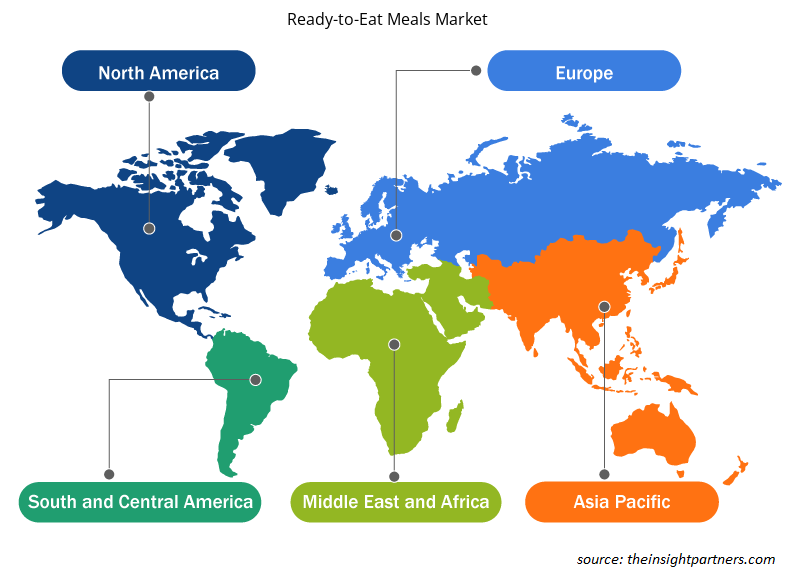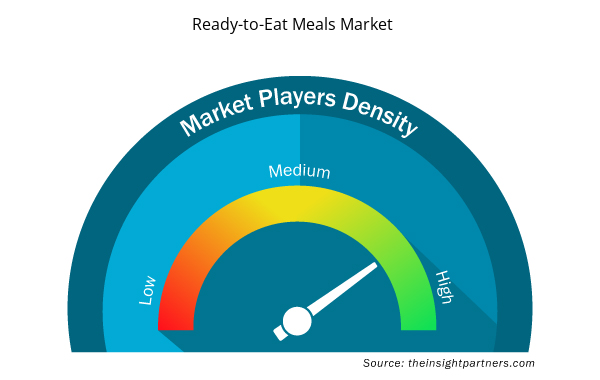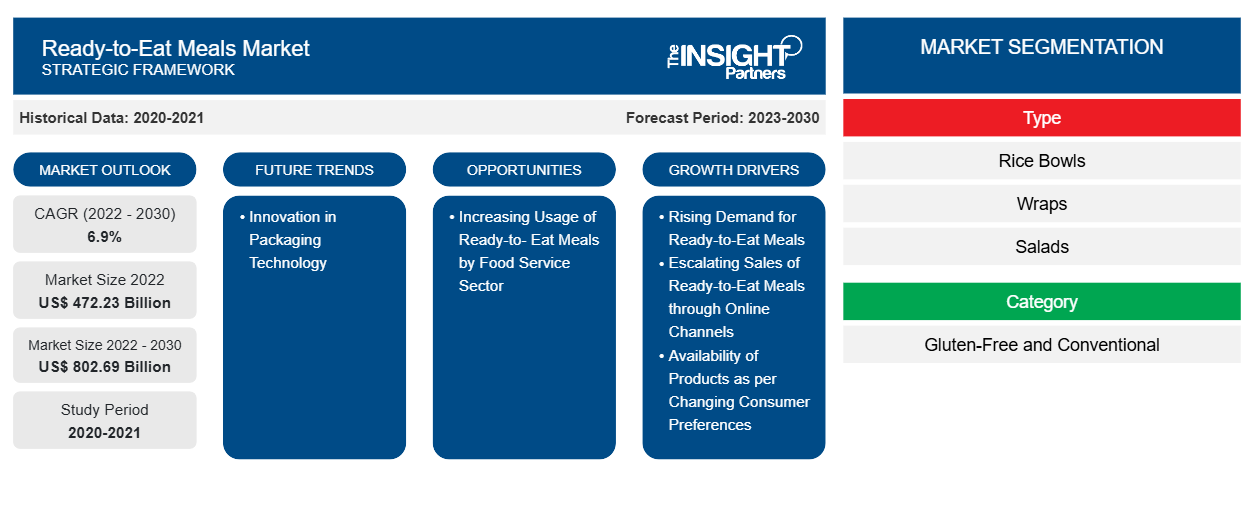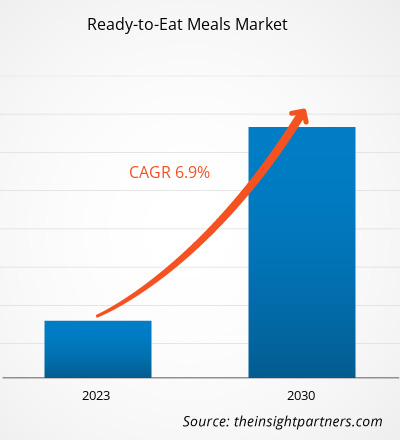[研究报告] 即食食品市场预计将从 2022 年的 4722.3163 亿美元增长到 2030 年的 8026.8921 亿美元;预计 2022 年至 2030 年的复合年增长率为 6.9%。
市场洞察和分析师观点:
即食食品是方便食品,可以在旅途中轻松食用。三明治、卷饼、披萨、汉堡、面条和意大利面、咖喱和肉汁、墨西哥卷饼和米饭碗是一些广泛食用的即食食品。由于企业部门的增长、双收入家庭数量的增加以及工作时间的延长,全球人民的生活方式发生了巨大变化。人们更喜欢即食食品,以避免烹饪时间和精力。这一因素极大地促进了全球即食食品市场的增长。
根据类别,即食食品市场分为无麸质和传统食品。该地区麸质不耐症的患病率不断上升,加上人们对无麸质产品的健康益处的认识不断提高,是推动无麸质即食食品需求的关键因素。此外,随着消费者能够更全面地接触各种无麸质即食食品品牌,预计该类别将在未来几年出现大幅增长。
定制此报告以满足您的需求
您可以免费定制任何报告,包括本报告的部分内容、国家级分析、Excel 数据包,以及为初创企业和大学提供优惠和折扣
- 获取此报告的关键市场趋势。这个免费样品将包括数据分析,从市场趋势到估计和预测。
增长动力和挑战:
高品质方便食品的消费已成为食品行业最大的趋势之一。方便食品,如即食产品、即食餐和冷冻产品,可以让消费者节省购买食材、准备和烹饪食物、食用和餐后活动的时间和精力。便利性和口味是全球消费者在购买食品时的主要期望属性。根据“国际食品信息委员会 (IFIC)”的食品和健康调查,便利性是千禧一代购买食品的主要驱动力。同时,口味对婴儿潮一代来说至关重要。
超市配送服务(如 Amazon Fresh 和 Instacart)和餐食配送公司(如 Blue Apron)都受益于人们对便利性和质量的日益增长的偏好。此外,由于冷链供应链的发展,他们发现 RTE 食品处理变得容易。这些因素推动了全球对方便食品的需求。
由于全球小家庭和双收入家庭的数量不断增加,即食食品等方便食品越来越受欢迎。由于工作日程繁忙,千禧一代更喜欢高效利用时间,避免繁琐的任务。即食食品经过加工并采用保鲜技术,从而延长了产品的保质期。节省的准备食物的精力和时间以及储存和运输的便利性进一步促进了其需求。根据国际食品信息委员会的“2020 年食品与健康调查”,在 1,011 名美国人(年龄在 18 至 80 岁之间)中,19% 的消费者更多地食用食品储藏室或冰箱中的预制食品。
根据 2020 年 Eating Better 即食食品快照调查,英国 88% 的成年人吃即食早餐和晚餐或即食食品。五分之二的人每周吃包装好的即食食品。因此,为了节省时间和精力,对即食食品等方便食品的需求不断增长,推动了全球即食食品市场的发展。
来自北美的美国工作专业人士数量激增。根据加拿大就业和社会发展部 (ESDC) 的数据,加拿大 2022 年女性和男性的劳动参与率为 88.142%,高于 2021 年的 87.075%。劳动人口数量的增加导致对方便食品(如即食食品)的需求更加强劲,这有助于节省时间和精力。超市、大卖场和在线零售等成熟的分销渠道使这些产品进入该地区的各个家庭,推动了北美即食食品市场的发展。在 COVID-19 疫情期间,网上购物平台获得了巨大的吸引力。根据美国外国农业服务局的数据,2022 年,加拿大零售食品行业出现了集中复苏,总销售额达到约 295 亿美元,比 2021 年增长 20.9%。因此,加拿大零售业高度多样化,预计将为即食食品市场提供新的机会。因此,上述所有因素都在推动即食食品市场的增长。
报告细分和范围:
“全球即食食品市场”根据类型、类别、最终用户和地理位置进行细分。根据类型,市场细分为米饭碗、卷饼、沙拉、墨西哥卷饼、肉汁和咖喱、面条和意大利面、披萨、汤和炖菜、肉类主菜、汉堡、三明治等。面条和意大利面在全球即食食品市场中占有最大份额。根据地理位置,即食食品市场细分为北美(美国、加拿大和墨西哥)、欧洲(德国、法国、意大利、英国、俄罗斯和欧洲其他地区)、亚太地区(澳大利亚、中国、日本、印度、韩国和亚太地区其他地区)、中东和非洲(南非、沙特阿拉伯、阿联酋和中东和非洲其他地区)以及南美洲和中美洲(巴西、智利和南美洲和中美洲其他地区)。
节段分析:
根据类型,即食餐市场细分为米饭碗、卷饼、沙拉、墨西哥卷饼、肉汁和咖喱、面条和意大利面、披萨、汤和炖菜、肉类主菜、汉堡包等。面条和意大利面部分在 2022 年占据即食餐市场的最大份额。沙拉部分预计在预测期内将实现更高的复合年增长率。即食意大利面餐有多种类型,例如意大利面条、通心粉、意大利宽面条和通心粉。意大利面餐包括虾、肉丸、鸡肉和植物性蛋白质来源等蛋白质来源。包装好的意大利面餐设计用于快速食用,几乎不需要烹饪。即食意大利面餐装在单份容器中,因此更容易控制份量和重新加热。饮食习惯的改变、忙碌的生活方式、接触多元文化以及对各种美食和方便食品的需求增加是推动即食面条需求的关键因素。制造商推出了多种类别的即食面条,例如纯素面条、无麸质面条或有机面条,使其成为一种更方便的用餐选择。
区域分析:
即食食品市场分为五个主要区域——北美、欧洲、亚太、南美和中美以及中东和非洲。全球即食食品市场以亚太地区为主,预计 2022 年市场规模约为 1500 亿美元。亚太地区的即食食品市场分为澳大利亚、中国、印度、日本、韩国和亚太其他地区。中产阶级人口的城市化进程加快和可支配收入的增加推动了对即食食品的需求,包括汉堡、三明治、面条、意大利面和披萨。根据国际劳工组织 (ILO) 的数据,2021 年亚太国家的总收入增长了 3.5%,其中中国在 2021 年占 0.3%,在 2022 年上半年占 0.7%。
中亚和西亚的总收入增长了 12.4%。由于可支配收入增加、时间限制和繁忙的工作日程,上班族更喜欢方便食品,例如米饭、卷饼、沙拉、面包卷、肉汁和咖喱、面条和意大利面、披萨以及汤和炖菜。
就机遇而言,亚太地区的即食食品市场具有巨大的创新潜力。制造商专注于产品开发,推出新的口味、配料和烹饪技术,以满足消费者多样化的口味和偏好。此外,针对学校、学院和公司办公室等机构提供定制的餐饮解决方案,为在亚太即食食品市场运营的企业创造了新的收入来源。
西方生活方式和饮食习惯的影响是推动亚太地区即食食品需求的另一个主要因素。然而,消费者的价格敏感性对亚太地区即食食品行业的发展构成了重大挑战。
行业发展和未来机遇:
以下列出了全球即食食品市场的主要参与者采取的各种举措:
- 2020 年 12 月,雀巢公司在中国推出了 Harvest Gourmet 的植物基即食食品产品线。产品线包括汉堡、香肠、鸡块、肉末以及宫保鸡丁、红烧丸子、五花肉和麻辣锅等植物基食品。
- 2021年6月,美国食品加工商“泰森食品公司”在亚太地区推出植物基即食食品。
- 2020 年 12 月,雀巢公司旗下即食餐食配送服务公司 Freshly Inc. 推出了即食餐食产品。这些产品不含麸质,标签清洁,且采用全食品原料制成。
即食食品市场区域洞察
Insight Partners 的分析师已详尽解释了预测期内影响即食食品市场的区域趋势和因素。本节还讨论了北美、欧洲、亚太地区、中东和非洲以及南美和中美洲的即食食品市场细分和地理位置。

- 获取即食食品市场的区域特定数据
即食食品市场报告范围
| 报告属性 | 细节 |
|---|---|
| 2022 年市场规模 | 4722.3亿美元 |
| 2030 年市场规模 | 8026.9亿美元 |
| 全球复合年增长率(2022 - 2030 年) | 6.9% |
| 史料 | 2020-2021 |
| 预测期 | 2023-2030 |
| 涵盖的领域 | 按类型
|
| 覆盖地区和国家 | 北美
|
| 市场领导者和主要公司简介 |
|
即食食品市场参与者密度:了解其对业务动态的影响
即食食品市场正在快速增长,这得益于终端用户需求的不断增长,而这些需求又源于消费者偏好的不断变化、技术进步以及对产品优势的认识不断提高等因素。随着需求的增加,企业正在扩大其产品范围,进行创新以满足消费者的需求,并利用新兴趋势,从而进一步推动市场增长。
市场参与者密度是指在特定市场或行业内运营的企业或公司的分布情况。它表明在给定市场空间中,相对于其规模或总市场价值,有多少竞争对手(市场参与者)存在。
在即食食品市场运营的主要公司有:
- 泰森食品公司
- SK 冷藏食品
- 新鲜烧烤食品有限公司
- 丹迪三明治公司
- 泰勒农场
免责声明:上面列出的公司没有按照任何特定顺序排列。

- 获取即食食品市场顶级关键参与者概述
COVID-19 疫情影响:
COVID-19 疫情影响了各国的经济和行业。北美、欧洲、亚太地区 (APAC)、南美和中美以及中东和非洲 (MEA) 主要国家的封锁、旅行禁令和企业停工对包括食品和饮料在内的各个行业的增长产生了负面影响。制造部门的关闭扰乱了全球供应链、制造活动、交付计划以及各种必需品和非必需品的销售。多家公司宣布,2020 年产品交付可能会延迟,其产品未来销量可能会下滑。此外,欧洲、亚太地区和北美各国政府对国际旅行实施的禁令迫使各公司暂时搁置合作和伙伴关系计划。此外,由于封锁而关闭的屠宰场也对市场增长产生了负面影响。所有这些因素都阻碍了 2020 年和 2021 年初的食品和饮料行业,从而抑制了即食食品市场的增长。
竞争格局和重点公司:
泰森食品公司 (Tyson Foods Inc.)、SK Chilled Foods、Fresh Grill Foods LLC、Dandee Sandwich Co.、Taylor Farms、Calavo Growers Inc.、Hearthside Food Solutions LLC、EA Sween、FreshRealm 和 TripleSticks 是全球即食食品市场的知名企业。这些即食食品制造商提供具有创新功能的尖端萃取解决方案,为消费者带来卓越的体验。
- 历史分析(2 年)、基准年、预测(7 年)及复合年增长率
- PEST 和 SWOT 分析
- 市场规模价值/数量 - 全球、区域、国家
- 行业和竞争格局
- Excel 数据集


- Bioremediation Technology and Services Market
- Radiopharmaceuticals Market
- Medical and Research Grade Collagen Market
- Analog-to-Digital Converter Market
- Excimer & Femtosecond Ophthalmic Lasers Market
- Dairy Flavors Market
- Formwork System Market
- Hydrogen Storage Alloys Market
- Transdermal Drug Delivery System Market
- Flexible Garden Hoses Market

Report Coverage
Revenue forecast, Company Analysis, Industry landscape, Growth factors, and Trends

Segment Covered
This text is related
to segments covered.

Regional Scope
North America, Europe, Asia Pacific, Middle East & Africa, South & Central America

Country Scope
This text is related
to country scope.
常见问题
Based on category, the ready-to-eat meals market is segmented into gluten-free and conventional. The conventional segment led the market. The demand for conventional ready-to-eat meals is expected to decrease as consumers are becoming more health-conscious and prefer healthy alternatives such as gluten-free ready-to-eat meals. However, conventional ready-to-eat meals are easily available in the market; thus, many customers prefer them based on their high availability. Further, the high demand for regular meals and the comparatively low price of conventional ready-to-eat meals drives the market for conventional ready-to-eat meals.
Ready-to-eat meals come in fresh or frozen form and can be purchased from retail stores or served in restaurants and institutions. Since ready-to-meals are pre-cooked, it is prone to contamination by microbes and requires suitable packaging that provides prolonged shelf life to the product. Innovations in ready-to-eat meal packaging include microwavable packaging, vacuum skin packaging, resealable packs, smart packaging, edible packaging, portion-controlled and single-serve packaging, and biodegradable packs. Food packaging innovations have significantly impacted the ready-to-eat meals market by increasing convenience, freshness, and sustainability. Manufacturers also offer ready-to-eat meals in retort-packaging due to their shelf-life enhancement of up to 18 to 24 months without refrigeration.
Ready-to-eat meals are also offered in packages with resealable closures, ensuring appropriate storage of unused or remaining food. Smart packaging containing ready-to-eat meals features an RFID tag, allowing consumers to access cooking instructions, ingredient details, and other information. Meanwhile, the rising pressure upon manufacturers to offer products that are environment-friendly continues to shift the concept of packaged food boxes toward more vegan/plant-based ingredients and the use of sustainable packaging with less plastic and waste. For instance, in September 2021, Walki-a, a company specializing in consumer and industrial packaging, introduced a tray portfolio for frozen and packaged foods, and they are claimed to be recyclable in paper streams. These newly launched trays include the Walki Pack Tray PET, with a thin PET lining that is classified as mono-material, making it suitable for recycling in paper streams. Similarly, in 2023, Amcor partnered with Tyson Foods to launch a sustainable package for consumer products. Tyson Foods offers egg bites and frittatas packed in AmPrima recycled ready forming/non-forming flexible film, featuring a 70% carbon footprint and addressing sustainable needs.
Thus, innovation in packaging technology is expected to create a new trend in the ready-to-eat meals market during the forecast period.
In 2022, Asia Pacific region accounted for the largest share of the global ready-to-eat meals market. The ready-to-eat meals market in Asia Pacific is segmented into Australia, China, India, Japan, South Korea, and the Rest of Asia Pacific. The growing urbanization and rising disposable income of the middle-class population propel the demand for ready-to-eat meals, including burgers, sandwiches, noodles, pasta, and pizza. According to the International Labour Organization (ILO), the total income of Asia Pacific countries increased by 3.5% in 2021, wherein China accounted for 0.3% in 2021 and 0.7% in the first half of 2022. Similarly, total income grew by 12.4% in Central and Western Asia. Owing to the rising disposable income, time constraints, and busy work schedules, working professionals prefer convenient food options such as rice bowls, wraps, salads, rolls, gravies and curries, noodles and portions of pasta, pizza, soups, and stews. Additionally, the growing tourism industry, encompassing the HoReCa industry, fuels the demand for ready-to-eat meals, offering tourists and travelers a taste of local and international cuisine without requiring lengthy preparation times.
The major players operating in the global ready-to-eat meals market are Tyson Foods Inc, SK Chilled Foods, Fresh Grill Foods LLC, Dandee Sandwich Co, Taylor Farms, Calavo Growers Inc, Hearthside Food Solutions LLC, EA Sween, FreshRealm, and TripleSticks among others.
Based on product type, the ready-to-eat meals market is categorized into rice bowls, wraps, salads, burritos, gravies and curries, noodles and pastas, pizza, soups and stews, meat entrées, burgers, sandwiches, and others. The salads segment is expected to register the highest CAGR during 2022–2030. Preparing salad requires vegetables, legumes, grains, meat, dressing, and other ingredients. Salad preparation also requires several steps, such as washing, cutting, or sauteing. Major market players offer pre-washed, ready-to-eat salad for convenient and hassle-free meals. Microgreens are added to enhance flavor and salad dressing, including black pepper, mustard powder, sugar, and salt. Manufacturers enhance salad portfolios due to the changing food consumption habits of health-conscious consumers.
The consumption of high-quality convenience food has become one of the biggest trends in the food industry. Convenience food, such as ready-to-eat products, ready-to-eat meals, and frozen products, allows consumers to save time and effort associated with ingredient shopping, meal preparation and cooking, consumption, and post-meal activities. Convenience and taste are the major desired attributes among consumers across the globe while buying food. According to the Food and Health Survey of the "International Food Information Council (IFIC)," convenience is a key driver for millennials while purchasing food. At the same time, taste is essential for baby boomers. Supermarket delivery services—such as Amazon Fresh and Instacart—and meal kit delivery companies—such as Blue Apron—have benefited from the rising preference for convenience and quality. Moreover, they find RTE food handling easy due to the existence of evolved cold supply chains. Such factors boost the demand for convenience food across the globe. Convenience foods such as ready-to-eat meals are gaining popularity owing to the increasing number of smaller households and dual-income families across the globe. Owing to their hectic work schedules, millennials prefer to be efficient with their time and avoid tedious tasks. Ready-to-eat meals are processed and involve preservation technology, thereby extending product shelf life. The efforts and time saved on food preparation and its convenience of storage and transport have further aided in boosting its demand. According to the “Food and Health Survey 2020” by the International Food Information Council, of 1,011 Americans (aged between 18 and 80 years), 19% of consumers ate more pre-made meals from their pantry or freezer.
Trends and growth analysis reports related to Food and Beverages : READ MORE..
The List of Companies - Ready-to-Eat Meals Market
- Tyson Foods Inc
- SK Chilled Foods
- Fresh Grill Foods LLC
- Dandee Sandwich Co
- Taylor Farms
- Calavo Growers Inc
- Hearthside Food Solutions LLC
- EA Sween
- FreshRealm
- TripleSticks
The Insight Partners performs research in 4 major stages: Data Collection & Secondary Research, Primary Research, Data Analysis and Data Triangulation & Final Review.
- Data Collection and Secondary Research:
As a market research and consulting firm operating from a decade, we have published and advised several client across the globe. First step for any study will start with an assessment of currently available data and insights from existing reports. Further, historical and current market information is collected from Investor Presentations, Annual Reports, SEC Filings, etc., and other information related to company’s performance and market positioning are gathered from Paid Databases (Factiva, Hoovers, and Reuters) and various other publications available in public domain.
Several associations trade associates, technical forums, institutes, societies and organization are accessed to gain technical as well as market related insights through their publications such as research papers, blogs and press releases related to the studies are referred to get cues about the market. Further, white papers, journals, magazines, and other news articles published in last 3 years are scrutinized and analyzed to understand the current market trends.
- Primary Research:
The primarily interview analysis comprise of data obtained from industry participants interview and answers to survey questions gathered by in-house primary team.
For primary research, interviews are conducted with industry experts/CEOs/Marketing Managers/VPs/Subject Matter Experts from both demand and supply side to get a 360-degree view of the market. The primary team conducts several interviews based on the complexity of the markets to understand the various market trends and dynamics which makes research more credible and precise.
A typical research interview fulfils the following functions:
- Provides first-hand information on the market size, market trends, growth trends, competitive landscape, and outlook
- Validates and strengthens in-house secondary research findings
- Develops the analysis team’s expertise and market understanding
Primary research involves email interactions and telephone interviews for each market, category, segment, and sub-segment across geographies. The participants who typically take part in such a process include, but are not limited to:
- Industry participants: VPs, business development managers, market intelligence managers and national sales managers
- Outside experts: Valuation experts, research analysts and key opinion leaders specializing in the electronics and semiconductor industry.
Below is the breakup of our primary respondents by company, designation, and region:

Once we receive the confirmation from primary research sources or primary respondents, we finalize the base year market estimation and forecast the data as per the macroeconomic and microeconomic factors assessed during data collection.
- Data Analysis:
Once data is validated through both secondary as well as primary respondents, we finalize the market estimations by hypothesis formulation and factor analysis at regional and country level.
- Macro-Economic Factor Analysis:
We analyse macroeconomic indicators such the gross domestic product (GDP), increase in the demand for goods and services across industries, technological advancement, regional economic growth, governmental policies, the influence of COVID-19, PEST analysis, and other aspects. This analysis aids in setting benchmarks for various nations/regions and approximating market splits. Additionally, the general trend of the aforementioned components aid in determining the market's development possibilities.
- Country Level Data:
Various factors that are especially aligned to the country are taken into account to determine the market size for a certain area and country, including the presence of vendors, such as headquarters and offices, the country's GDP, demand patterns, and industry growth. To comprehend the market dynamics for the nation, a number of growth variables, inhibitors, application areas, and current market trends are researched. The aforementioned elements aid in determining the country's overall market's growth potential.
- Company Profile:
The “Table of Contents” is formulated by listing and analyzing more than 25 - 30 companies operating in the market ecosystem across geographies. However, we profile only 10 companies as a standard practice in our syndicate reports. These 10 companies comprise leading, emerging, and regional players. Nonetheless, our analysis is not restricted to the 10 listed companies, we also analyze other companies present in the market to develop a holistic view and understand the prevailing trends. The “Company Profiles” section in the report covers key facts, business description, products & services, financial information, SWOT analysis, and key developments. The financial information presented is extracted from the annual reports and official documents of the publicly listed companies. Upon collecting the information for the sections of respective companies, we verify them via various primary sources and then compile the data in respective company profiles. The company level information helps us in deriving the base number as well as in forecasting the market size.
- Developing Base Number:
Aggregation of sales statistics (2020-2022) and macro-economic factor, and other secondary and primary research insights are utilized to arrive at base number and related market shares for 2022. The data gaps are identified in this step and relevant market data is analyzed, collected from paid primary interviews or databases. On finalizing the base year market size, forecasts are developed on the basis of macro-economic, industry and market growth factors and company level analysis.
- Data Triangulation and Final Review:
The market findings and base year market size calculations are validated from supply as well as demand side. Demand side validations are based on macro-economic factor analysis and benchmarks for respective regions and countries. In case of supply side validations, revenues of major companies are estimated (in case not available) based on industry benchmark, approximate number of employees, product portfolio, and primary interviews revenues are gathered. Further revenue from target product/service segment is assessed to avoid overshooting of market statistics. In case of heavy deviations between supply and demand side values, all thes steps are repeated to achieve synchronization.
We follow an iterative model, wherein we share our research findings with Subject Matter Experts (SME’s) and Key Opinion Leaders (KOLs) until consensus view of the market is not formulated – this model negates any drastic deviation in the opinions of experts. Only validated and universally acceptable research findings are quoted in our reports.
We have important check points that we use to validate our research findings – which we call – data triangulation, where we validate the information, we generate from secondary sources with primary interviews and then we re-validate with our internal data bases and Subject matter experts. This comprehensive model enables us to deliver high quality, reliable data in shortest possible time.


 获取此报告的免费样本
获取此报告的免费样本